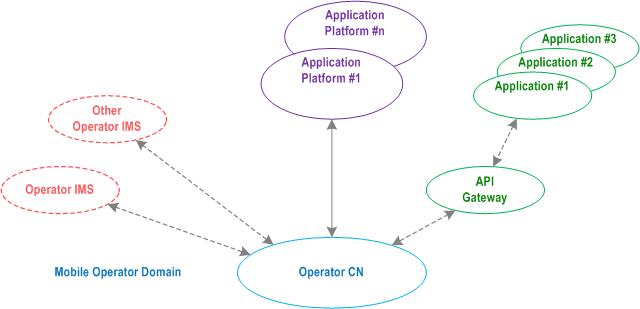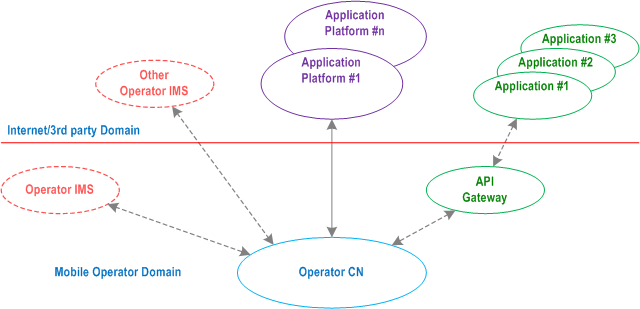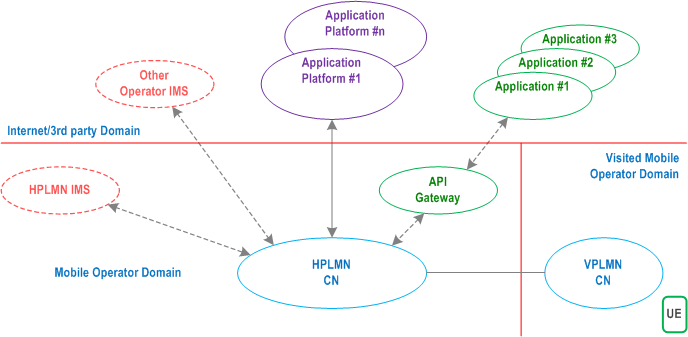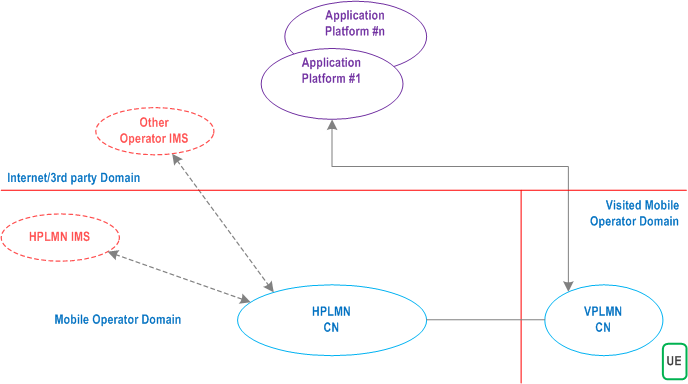Content for TS 22.278 Word version: 18.0.1
B1 Interworking between Mobile Operators and Data Application Providers
B1.1 Scenarios
B1.2 Use cases
B1 Interworking between Mobile Operators and Data Application Providers |R12| p. 42
This Annex provides various scenarios and use cases applicable for interworking between mobile operators and data applications.
B1.1 Scenarios p. 42
Figure B1.1-1 shows the non-roaming scenario where the mobile operator owns the EPS as well as application layer entities. Access and IP connectivity is provided by the mobile operator. Application platforms, also provided by the mobile operator, shown in the figure connect to the core network directly. Application platforms could be application servers (e.g. Video on Demand Server, PSS Server, MTC Server, etc.). Applications developed using APIs (e.g. REST, GSMA OneAPI) and resident on the API Gateway are connected to the operator core network via the API Gateway. The dashed lines between Operator CN and IMS as well as API Gateway are already specified.

Figure B1.1-2 provides the non-roaming scenario where the mobile operator does not own all the application layer entities. Access and IP connectivity is provided by the mobile operator. The 3rd party Application Platforms in this figure could be application servers (e.g. Video on Demand Server, PSS Server, MTC Server, etc.) or could be 3rd party software development platforms. The horizontal line represents the demarcation between the mobile operator domain and the 3rd party application provider domain. The mobile operator and 3rd party application providers may have agreements.

Figure B1.1-3 provides the roaming scenario for both the above owned and collaborative scenarios. This figure shows the home-routed scenario where all traffic is routed to home mobile operator EPS and applications are delivered via roaming agreements between mobile operators.

Figure B1.1-4 provides the roaming scenario between mobile operators and 3rd party application provider domains. In this scenario the application provider has agreements with visited mobile operator. This figure shows the local-breakout scenario where all traffic is routed to application domain from the visited operator network.

B1.2 Use cases p. 44
B1.2.1 Use cases for owned / collaborated scenarios. p. 44
Pre-conditions
A data application provider X develops an application customized for streaming high definition movies to the mobile end user over 3GPP access.
The data application provider X develops this application specifically for a mobile network operator (MNO) Y. The data application provider X hosts this application and establishes agreements with a mobile network operator (MNO) Y to pilot the service. Authentication and charging are provided by the MNO Y. The data application provider X can collaborate with other MNOs as well.
Alice has subscribed to a 3GPP device and video services from the MNO Y.
Use case 1: Authentication and Authorization
Alice gets onto a train for 4-hour long ride to a neighboring country. She turns on her device and looks at the movie catalog. She decides to view a movie and selects the movie offered by the data application provider X and watches it without worrying about the radio access network she is using and any additional login/password procedures.
Use case 2: Allocation of resources and other policy interactions
All along the MNO Y manages the resources and the QoS needed for high definition movie streaming to Alice. On the train, Alice gets distracted by the scenery and misses a few scenes. She rewinds and views the missing scenes.
Use case 3: Simultaneous interactions with multiple application providers
Alice comes across an interesting gadget in the movie and decides to pause on that scene and get a higher resolution closeup view. The close up view prompts an advertisement to pop up for the gadget. Based on this advertisement, Alice purchases the gadget. She is given the choice of paying immediately or being charged on her MNO monthly bill. She decides to charge to her MNO bill.
Use case 4: Roaming
Alice continues watching the movie and the train crosses the country border. She starts roaming into another MNO Z, which has roaming agreement with MNO Y. The movie quality is unaltered in the process of roaming.
Use case 5: Charging
She gets a bill from the MNO at the end of the month which includes the price for the movie she watched on the train and the gadget she purchased.
B1.2.2 Use cases for non-collaborated scenarios. p. 45
B1.2.2.1 UE initiates and requests MNO for preferential traffic handling p. 45
Pre-conditions
Alice decides to watch a movie. She turns on her device, registers with the network operated by MNO Y and launches the application to browse the movie catalogue. She decides to view a movie so she selects it and starts to watch it.
Use case 7: Allocation of resources and other policy interactions
At some point in the movie (e.g. due to mobility, network congestion, etc) Alice becomes dissatisfied with the quality of the movie.
Alice requests preferential traffic handling from MNO Y.
Alternative 1. Alice does not notice any improvement in the quality of the streamed movieand she does not confirm the request for preferential traffic handling within the preview period.
Alternative 2. Alice notices a marked improvement in the quality of the streamed movie and she confirms the request for preferential traffic handling.
As the train crosses the national boarder between Country A and Country B, Alice is notified of the change in MNO and charging.
Alternative 3. Alice decides not to consent for the additional charge. The quality of the bearer reverts to its default level after the specified consent period has expired.
Alternative 4. Alice decides to pay additional charge and consents. The quality of the bearer remains at its present level.
Use case 8: Charging
Alternative 1. Alice receives a bill from MNO Y at the end of the month that includes roaming charges from MNO Z, but no additional charges for preferential traffic handling.
Alternative 2 + Alternative 3. Alice receives a bill from MNO Y at the end of the month that includes roaming charges from MNO Z, and the cost for preferential traffic handling from MNO Y.
Alternative 2 + Alternative 4. Alice receives a bill from MNO Y at the end of the month that includes roaming charges from MNO Z, as well as the cost for preferential traffic handling from MNO Y and the additional cost for preferential traffic handling from MNO Z.
Alice does not receive any bill from DAP X related to the request for preferential traffic handling.
- Mobile Network Operator Y (MNO Y) has no business relationship nor is there any service collaboration with Data Application Provider X (DAP X).
- DAP X develops a free application customized for streaming movies to the mobile end user over 3GPP access. DAP X develops the application independently from MNO Y and hosts this application outside of MNO Y's network. The user accesses the service via the network of MNO Y connected to DAP X via a transit network. The service is provided to the user transparently through MNO Y's network.
- The network of MNO Y supports tiered bearers and MNO Y offers prefential traffic handling on demand from users with a preview period defined either by the operator or the application provider for acceptance of the service. MNO Y has a roaming agreement with MNO Z to provide preferential traffic handling for users at an extra cost to the user. MNO Y has no knowledge or control of the service being delivered by DAP X. Further MNO Y has no knowledge of the resources available at DAP X or of those in the transit network through which it is connected.
- Alice has subscribed to a 3GPP data service from MNO Y and has downloaded the free movie streaming application from DAP X. She has purchased credit through the application to enable streaming of content. No further authentication of authorisation is required with DAP X in order for Alice to receive content. The movie streaming application uses default level of resources and QoS (e.g. best effort, or based the subscriber profile) from the PLMN.
- Alice is on a train travelling across national boarder from Country A to Country B. Country A is served by MNO Y. Country B is served by MNO Z.
B1.2.2.2 UE initiates and Data Application Provider requests MNO for preferential traffic handling p. 46
Pre-conditions
At some point in the movie (e.g. due to mobility, network congestion, etc) Alice becomes dissatisfied with the quality of the movie. Alice requests preferential traffic handling from DAP X.
Alternatives 1 to are as described in Use case 2 under B1.2.X.
Use case 10: Charging
Alternative 1. Alice receives a bill from MNO Y at the end of the month that includes roaming charges from MNO Z.
Alternative 2 + Alternative 3. Alice receives her bill from MNO Y at the end of the month that includes roaming charges from MNO Z. In addition, Alice receives a statement from DAP X which includes an entry for the cost of preferential traffic handling from MNO Y.
Alternative 2 + Alternative 4. Alice receives her normal bill from MNO Y at the end of the month including roaming charges from MNO Z. In addition, Alice receives a statement from DAP X which includes an entry for the cost of preferential traffic handling from MNO Y and MNO Z.
- Mobile Network Operator Y (MNO Y) has a business relationship but no service collaboration with Data Application Provider X (DAP X). Other pre-conditions are as specified for B1.2.2.1